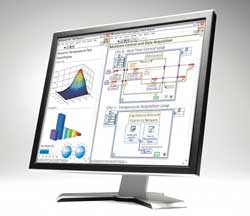
Posted to News on 18th Aug 2009, 13:57
LabVIEW 2009 helps to cut system cost and size
National Instruments is releasing LabVIEW 2009, the latest version of the graphical system design software platform for control, test and embedded system development. With this new version of LabVIEW, engineers and scientists can use virtualisation technology to reduce system cost and size, deploy distributed custom measurements across vast physical hardware systems with the new NI wireless sensor network (WSN) platform, and streamline algorithm design and deployment to embedded systems with real-time maths. LabVIEW 2009 also makes it possible to create digital prototypes with integrated SolidWorks mechatronics tools.

Dr James Truchard, president, CEO and co-founder of National Instruments, states: "In today's challenging economic climate, engineers and scientists are being asked to complete their projects with fewer resources and in less time. With new opportunities emerging from investments in infrastructure, renewable energy and clean technologies, medical research and device design, we focused our LabVIEW 2009 development to harness key technologies such as multicore, FPGA design, wireless platforms and real-time math to empower innovation in these areas."
Virtualisation and multicore processors
Virtualisation technology makes it possible to run multiple operating systems (OSs) side by side on the same multicore processing hardware to build more efficient systems. New NI Real-Time Hypervisor software combines the power of the LabVIEW Real-Time Module with general-purpose OS capabilities to reduce system cost and size while maintaining the determinism of the real-time application. Using this software, engineers and scientists can run Windows XP and LabVIEW Real-Time side by side on a single controller, partitioning the processor cores and I/O devices among the two OSs to achieve control and human machine interface (HMI) from a single system. The Real-Time Hypervisor works with dual- and quad-core NI PXI controllers as well as the NI 3110 industrial controller.
Deterministic distributed I/O
LabVIEW 2009 brings the benefits of field-programmable gate array (FPGA) software use to deterministic distributed I/O. With LabVIEW 2009, the NI 9144 expansion chassis for C Series modules becomes a LabVIEW FPGA target that can run custom timing, inline processing and time-critical control as distributed I/O. With FPGA computations running in the megahertz ranges, engineers and scientists can achieve ultra-fast control, perform signal processing and interface with digital protocols.
Wireless sensor networks
Additionally, technology advances have made it possible to deploy WSNs to perform distributed measurements across vast physical systems. Enhancing the wireless sensors with custom software logic traditionally has required knowledge of complex, low-level embedded programming. The new LabVIEW Wireless Sensor Network Module Pioneer gives engineers and scientists the ability to program individual NI WSN measurement nodes with the ease of use of graphical programming. Engineers and scientists can use LabVIEW to extend node battery life, increase acquisition performance and create custom sensor interfaces.
Integrated SolidWorks mechatronics tools
National Instruments collaborated with SolidWorks on a mechatronics tool that helps mechanical and control engineers work together to lower the cost and risk of machine design. The seamless integration of the Labview 2009 NI Softmotion Module and SolidWorks 3D CAD software delivers a design environment that is suitable for digital prototyping, helping engineers and scientists to design, optimise, validate and visualise the real-world performance of machines and motion systems before building physical prototypes. The digital prototype demonstrates not only the look but also the movements and operation of a future machine.
Built-in maths libraries
LabVIEW 2009 features built-in maths libraries that contain more than 1000 functions ranging from low-level, point-by-point signal processing to high-level, configuration-based implementations, all of which can easily be deployed to real-time embedded devices. With the LabVIEW Mathscript RT Module, LabVIEW 2009 further expands access to real-time maths, which is the implementation and deployment of mathematical algorithms to deterministic operating systems, for engineers and scientists using text-based maths tools. The module also provides engineers and scientists the ability to incorporate their own existing .m files using interactive user interfaces and real-world I/O and easily deploy them to real-time hardware for faster system prototyping. By simplifying the process of deploying maths algorithms to real-time hardware, LabVIEW 2009 helps engineers and scientists use advanced control and analysis to improve the performance of control and monitoring systems.
NI is adopting an annual release cycle for LabVIEW, with version names based on the year of release. The annual release cycle solidifies the schedule, stability and feature scope of each new release to provide an easy upgrade process for customers.
For more information, go to www.ni.com/labview/whatsnew or use the form on this page to request a callback or more information.
National Instruments Corporation (UK) Ltd
Measurement House, Newbury Business Park
London Road
RG14 2PZ
UNITED KINGDOM
+44 (0)1635 523545






























